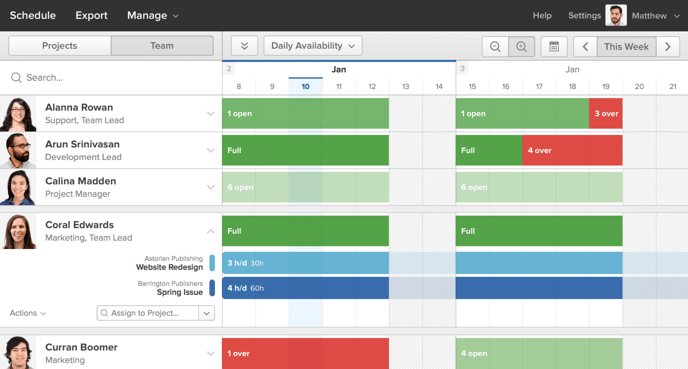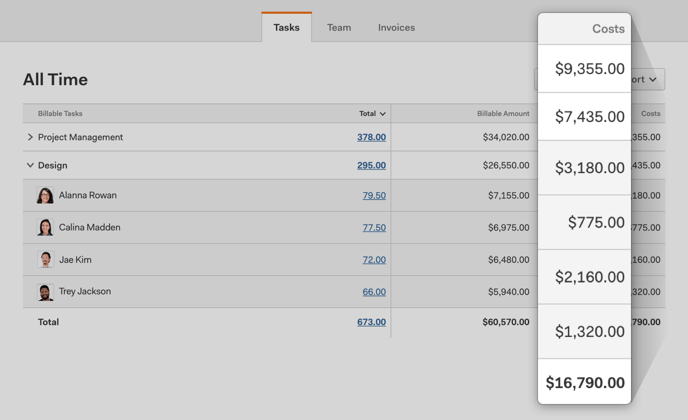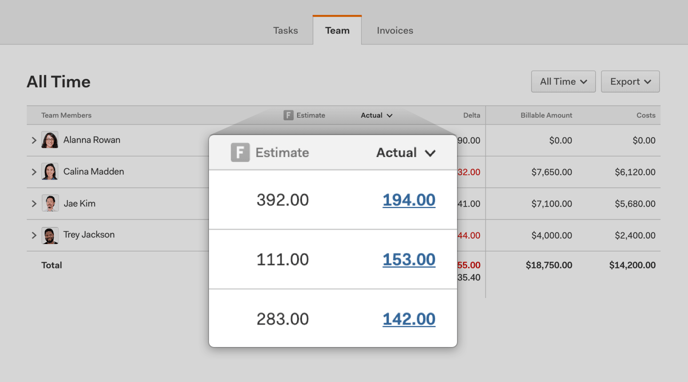Introduction
So, your business has a new project on the horizon. Awesome! But before the client signs on the dotted line, they want answers to some tough questions: How much is this project going to cost? When will it be done?
These questions aren’t just important for your client, they’re crucial for your business as well. The answers serve as the foundation of every project. They determine who’s going to be working on it and for how long. They can even determine whether you make money, or lose it.
Even with the stakes this high, many businesses still don’t have an organized method for coming up with estimates. Too often they’re just picking a number out of a hat or spinning a wheel and hoping it lands on something that will make a profit.
There’s no switch you can flip to automatically start making better estimates. But, with the help of time tracking, it is possible to take a more data-driven approach that reduces the risk of losing money on a project. Here’s how to get started:
Laying the groundwork
As a client services business, the most valuable data you can have is information about where your time is going, because, at the end of the day, time is what you’re selling.
In order to estimate future projects, you need to know how long similar projects took to complete in the past and how much they cost you. The only way to get this information is to track time.
Time tracking sounds daunting, but if you set it up properly, it can be surprisingly easy. Here are some tips to make sure you get data that’s actually useful:
1. Track time to specific projects
Make sure you’re tracking time to individual projects, and that those projects correspond to projects you bill for. This will make sure your data is packaged in a useful way.
2. Track time to specific tasks
Inside each project you also need to track time to specific tasks, such as design or project management or meetings. This will help you drill down into the cost of specific tasks.
3. Everyone needs to track time
Every person who works on a project needs to track their time to it, otherwise your data will be incomplete.
4. Make sure the data is accurate
Your team should track the actual time they spend working on a project. Make sure they’re not just entering some ‘magic number’ they think you want to see. If your data isn’t accurate, your estimates will be off.
5. Identify which time belongs to which people
Different people at your company are probably paid at different rates. In order to figure out the true cost of a project, you need the ability to break down time by each individual.
6. Organize your data
You want to be able to refer back to your data every time you start a new project. Maintaining a library of past projects with organized timesheet data will save you time in the future. If possible, group similar projects together with something like a project code.
Estimating the project timeline
Once your time tracking has been humming along for a couple projects, you can start putting it to use. When tackling an estimate, the easiest place to start is with how long a project will take. Once you feel good about the project timeline, you can then estimate how much it’ll cost.
The first step is to look back through the library of projects you’ve collected data for. You want to find projects similar to the one you’re about to start. If your prospective client has come to you with a website redesign, look back at site redesigns you’ve done in the past. If you’re about to embark on building a mobile app, look back at other app projects.
Once you’ve identified the relevant projects, the first thing to look at is the total number of hours that went into them. This gives you a rough idea of the timeframe you’re working with for the new project. Next, dive into how many hours went into each project by role. How many hours did designers spend on it? How many hours did developers spend? What about project managers?
Obviously, every project is different, and you’ll have to make adjustments for the specifics of this particular project. But looking back at past projects gives you a solid starting place for estimating how much time each role will need to spend on the project.
Once you feel good about this number, you can match that up with your team’s capacity over the next few months. Ideally you should already have a system for tracking how many hours each team member is scheduled to work over the next few months and how much new work they can take on. (If you don’t, may we suggest you check out Harvest Forecast.)

Match up the number of hours required from each role with the availability of people in that role. If you estimate the project will require thirty hours of design time, and you have a designer without anything on her plate, she might be able to wrap things up in a week or two. But if it’s also going to require twenty hours of development, and all your developers are busy on other work for the rest of the month, that’s going to push the deadline out a bit.
Once you’ve matched up the hours you think the project is going to take with your team’s current capacity you should have a pretty accurate estimate of when the project will be done.
When businesses get estimates wrong, it’s usually because they underestimate how long something is going to take. Don’t forget to account for unforeseen circumstances that might cause the project to get a little behind schedule. If you think a project is only going to take six weeks, and then you charge your client for exactly six weeks of work, you’ll have to pay out of pocket for the extra costs if the project unexpectedly takes eight weeks. Don’t forget to give yourself a little bit of wiggle room.
Estimating project costs
Now comes the hard part—figuring out how much to charge. There are several methods you can use to price your projects. How much you ultimately end up charging will depend a lot on which pricing method you use and the individual circumstances of your business.
However, there is one basic rule that applies to (almost) all projects: you need to charge your client more than it costs you to do the work. In other words, you want to make money—not lose money—on the project.
So the essential first step in figuring out how much to charge your client is to estimate how much it’s going to cost you to complete this particular project. Once you know that amount, you can then factor in the fixed costs associated with running your business and a profit margin, and this is what you’ll actually end up charging the client.
To figure out your costs, you’re going to make use of the estimate you came up with for how long the project is going to take. There are a couple different ways you can turn that number into an estimate of the project’s cost:
- Break down hours by individual - The most exact way to come up with an estimate is to figure out who’s going to work on this new project and how many hours each person is going to put in. You can then multiply this number by each person’s cost rate (effectively how much you pay them per hour) to come up with a total cost estimate.
- Break down hours by role - If there isn’t a tremendous amount of variation in salary within each role, you can break down the total number of hours each role will spend on the project (i.e. the total hours for all the designers, the total for developers, etc.). Then just multiply the total hours for each role by the average cost rate for each role.
- Use a blended rate - Some people find it faster to use a blended cost rate—a rate that represents the average for everyone on their team. That way they can just multiply the total number of hours estimated for the project by the blended rate and arrive at a ballpark cost.
No matter which method you choose, the total you arrive at represents a rough estimate of the cost of completing the project. Covering these costs is the bare minimum you need to charge your client.

Harvest lets you assign a cost rate to each person on your team, so you can track your costs while they track their time. Learn more
Improving your estimates
The important thing to keep in mind is that creating project estimates is an iterative process. The more you do it, the better you’ll get, in part because you’ll have more historical data to look back at. Here are some ways to ensure you get better with every estimate:
Figure out what went wrong
When you wrap up a project, stop to take note of how it worked out. Did it end up in the red? In other words, did it cost you more than you charged the client? If so, that probably means that your estimates were off.
It helps to understand why. Did the scope change? Was your team not using time efficiently? Did the client have a lot of feedback? Not only will having answers to these questions help you improve how a project is run, they’ll also help you refine future estimates as you get better at anticipating the unexpected.
Review individual estimates
It’s not enough just to look at whether the project as a whole made (or lost) money. Sometimes a profitable bottom line can disguise problems lurking under the surface.
Look back at your project timeline and how many hours you estimated for each person and task. Were your estimates for the amount of design that would have to go into the project way off? Why? Was there one individual who worked on the project way longer than you anticipated? Talking to your team and answering these questions will go a long way toward upping your estimate game.
Systematically comparing your estimates with the time your team actually tracked can help you come up with a ‘buffer’ that you can apply to future estimates to ensure you don’t get burned.

Connecting Harvest to its sister app Forecast makes it easy to compare your estimates to how much time people actually tracked. Learn more
Conclusion
This process may sound daunting if you’re starting from scratch, but once you get in the habit of collecting and analyzing time tracking data for every project you complete, it becomes relatively simple.
Improving estimates on your upcoming projects is only one of the many benefits of tracking time, which include billing your clients, keeping your projects profitable, and managing your team better. The only problem is that many people see time tracking as a pain. Their teams complain about having to do it and they just don’t think it’s worth the battle.
That’s why it makes sense to check out a tool like Harvest. It makes entering time simple for your team, removing friction with the help of intuitive timers, mobile apps, and integrations with your favorite tools. And it makes analyzing your projects easy on you by pulling timesheet data into intuitive visual reports. Learn more or try it free for 30 days.












